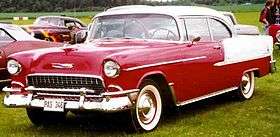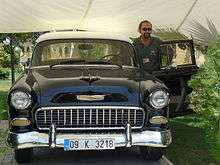1955 Chevrolet
| 1955 Chevrolet | |
|---|---|
 Bel Air | |
| Overview | |
| Manufacturer | Chevrolet (General Motors) |
| Also called |
Chevrolet Bel Air Chevrolet 210 Delray Chevrolet 150 Chevrolet Nomad Chevrolet Sedan Delivery[1] |
| Production | 1954–1955 |
| Assembly |
United States Canada[2] Woodville, Australia[3] |
| Body and chassis | |
| Body style |
2-door coupé 2-door hardtop 4-door sedan 2-door convertible 2-door Station wagon 4-door Station wagon 2-door sedan delivery[4] |
| Chronology | |
| Successor | 1957 Chevrolet |

The 1955 Chevrolet (sometimes referred to as '55 Chevy) is an automobile that was made by Chevrolet in 1955. It is considered a huge turning point for the manufacturer and a major success. It was available in three models: the 150, 210, and Bel Air.
The '55 Chevy was the first successful Chevrolet with an optional V8 engine. Chevrolet had produced an earlier car with a V8 in 1918 (Chevrolet Series D), which used a 36-horsepower and 288-cubic-inch V8, but it remained in production for only a year.[5] In 1955, Chevrolet decided to fit its new car with an overhead valve V8 engine design, which was similar to the 1949 Oldsmobile "Rocket 88" V8 engine. The new 265-cubic-inch overhead valve V8 was designed to be smaller, lighter, and more powerful than previous V8s in the auto industry.
The new "small block" in the '55 Chevy had its problems, however. It had no oil filter, and the factory could only add one externally—owners had to opt for an external oil filter. Those who did not order the engine with the "oil filter option" had dirty oil in a short amount of time. This was corrected for the next year.
The new small block V8 had an easy maintenance, and it had a built-in ability to be upgraded. The small block Chevy V8 became so popular that Chevrolet still sells it today. Although there have been various changes made to the motor to modernize it, the basic design of the original 265 remains.
Body design
Additionally, Chevrolet drastically changed its body design. It had smooth straight panels on the sides and hood, wrap-around glass on the windshield, and triangular tail lights that jutted outward. And this new look, combined with new power and engineering, made the '55 an instant hit and a critical success.
The car's popular "shoe-box" body style and chassis were carried over to 1956 (with changes to some of the front and rear aesthetics), and then carried over to 1957 (where the body was lengthened several inches in the rear and more drastic aesthetic changes were made).
Chevrolet retained the same body and chassis for the 1955, 56, and 57 model years. These years are extremely sought after by collectors and enthusiasts, and are often referred to by the given nickname of "tri-fives." The nickname "tri-fives" was given because there were three model years in the 1950s.
Options and trim

The 1955 Chevrolet also offered many other firsts for Chevrolet, including changing from a 6-volt to a 12-volt electrical system. The '55 offered new options like air conditioning, power windows, and even power seats; power steering and power brakes were also optional. Other options included automatic light dimmers, door handle protectors, bumper protectors and "wonder-bar" radios. So many new options were available that some referred to the car as "Chevy's little Cadillac." Never before had so many options been offered for a car in the low-price field.
The 55's top trim offering was the Bel-Air, which had more chrome than the 150 or 210. The Bel-Air and 210 could be bought with a post between the front and rear passenger windows, or without a post. Without a post it was known as a "Hardtop," which came only in a two-door and was not offered in a four-door hard top until 1956. The two-door hardtop was also known as the "Sport Coupe." Since the Sport Coupe had no post between the two side windows, it had a slightly shorter roof and longer rear deck. The Bel-Air was available in a convertible, with the same shorter roof and longer rear deck as the sport coupe. The convertible was offered in Bel-Air trim only. 1955 also saw the introduction of the Bel Air Nomad, a sporty two-door station wagon which featured frameless door glass and elongated side windows. The unique roof design of the Nomad came directly from the 1954 Corvette Nomad, a "dream car" designed to be shown at auto shows as a concept sport wagon. Although regarded as one of the most beautiful station wagon designs of Fifties, the Nomad sold poorly, partly due to its price tag (one of the most expensive models in the Bel Air lineup) as well as its lack of four doors.
The '55 offered a wide array of colors. One solid color, which was standard for the 150, could be had for the 210 or Bel Air...or nineteen different two-tone color combinations were also available.
Along with a standard column-mounted three speed Synchro-Mesh transmission, the buyer of a '55 Chevy could specify an optional Overdrive unit to go with the stickshift, or the fully automatic two-speed Powerglide transmission. Although most everything was new in 1955 for Chevrolet, the reliable Powerglide was mostly unchanged from '54.
Models
There were nine different variations of the three models made in 1955, with differences in body, roof type, number of doors, and available equipment, but not all possible combinations were sold.
| Name and Description | 150 Series | 210 Series | Bel Air Series |
|---|---|---|---|
| 4 Door Sedan: 6-passenger, 7-window sedan with a rear trunk. | X | X | X |
| 2 Door Sedan: 6-passenger, 5-window sedan with a rear trunk. | X | X | X |
| Club Coupe: 6-passenger, 2-door, 5-window coupe with a rear trunk. | X | ||
| Utility Sedan: 3-passenger, 5-window sedan with a rear trunk. | X | ||
| Sport Coupe: 6-passenger, 2-door, 5-window pillarless hardtop coupe with rear trunk. | X | X | |
| Convertible: 5-passenger, 2-door, 5-window coupe with folding top and rear trunk. | X | ||
| Nomad Wagon: 6-passenger, 2-door, 7 window "hardtop" wagon. | X | ||
| 2 Door Station Wagon: 6-passenger, 5-window wagon with drop and lift gates. | X | X | X |
| 4 Door Station Wagon: 6-passenger, 7 window wagon with drop and lift gates. | X | X | |
| Sedan Delivery: 2-passenger, 3 window, panel delivery wagon. | X |
Engines
The following engines were available on the 1955 Chevrolet:
- OHV Inline 6 cylinder: 235 cubic inches, 135 brake horsepower (SAE)
- OHV V8: 265 cubic inches, 162 brake horsepower (SAE)
- OHV V8: 265 cubic inches, 180 brake horsepower (SAE), also known as the "Power Pack" engine
- OHV V8: 265 cubic inches, 195 brake horsepower (SAE), late in the model year, known as the "Super Power Pack"
The 265 was new for 1955, and it was the first V8 available in a Chevrolet since 1919, when the Model "D" was offered. That car did not sell well due to its poor gasoline mileage, so Chevy reverted to OHV inline 4-cylinder engines until 1929 when Chevy switched to an inline 6-cylinder engine. This reliable six cylinder would power chevy cars until 1955 and was known as the "stove-bolt six" and also known as the "blue flame six". But the new 265 V-8 in 1955 offered more power than the optional blue flame six, and weighed 100 pounds less.
The 265 was a big success, and was fitted to the majority of Chevrolet cars for decades in various cubic inch displacements. It is commonly referred to as the "Small Block Chevy" motor.
Transmissions
The car contained one of three transmission types, all with the shifter on the column:
- 3-speed Synchromesh manual
- 3-speed Synchromesh manual with overdrive
- 2-speed automatic "powerglide."
All models had the three transmission options.
See also
1917-1918 Chevrolet Series D V8 previous Chevy V8
Note: The above mentioned horsepower rating of this early V-8 is wrong. It produced 36 h.p., not the 155 h.p. cited.
References
- ↑ 1955 Chevrolet Sedan Delivery brochure page, 1.bp.blogspot.com Retrieved on 8 November 2013
- ↑ Production Numbers, www.fiftyfivechev.com Retrieved on 8 November 2013
- ↑ Norm Darwin, 100 Years of GM in Australia, 2002, page 146
- ↑ 1955 Chevrolet Specifications - Model Identification, chevy.oldcarmanualproject.com Retrieved on 8 November 2013
- ↑ Lingeman, Jake. "Chevy D-Series passes through three generations before auction." Autoweek. Crain Communications, Inc., 13 Sept. 2012. Web. 22 Dec. 2014. Accessed 2014-12-22. Archived 2015-01-09.
| Wikimedia Commons has media related to 1955 Chevrolet Bel Air. |